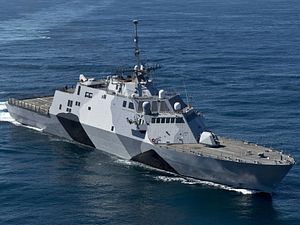The U.S. Navy is set to christen the future littoral combat ship (LCS) USS Minneapolis-Saint Paul (LCS 21) during a ceremony at the Fincantieri Marinette Marine (FMM) shipyard in Marinette, Wisconsin, on June 15, the service announced in a recent statement.
The Minneapolis-Saint Paul is the Navy’s 21st LCS overall, and the 11th of the Freedom variant. The U.S. Navy’s LCS fleet consists of the Independence and Freedom class. Construction of the Freedom variant is headed by Lockheed Martin at the FMM shipyard, whereas the building of Independence-class LCS is managed by Austal USA in Alabama. The Austal and Lockheed shipyards are each capable of building two LCS per year.
“The christening of the future USS Minneapolis-Saint Paul marks an important step toward this great ship’s entry into the fleet,” said Secretary of the Navy Richard V. Spencer. “The dedication and skilled work of our industry partners have ensured this ship will represent the great city of Minneapolis Saint Paul and serve of our Navy and Marine Corps team for decades to come.” As I noted previously:
[W]ith 40 percent of the hull reconfigurable, both LCS variants use an open architecture design, enabling the warships to be fitted with interchangeable so-called mission packages providing capabilities for surface warfare (SUW), anti-submarine warfare (ASW), and mine countermeasures (MCM) missions in the littoral zone. The ASW warfare package is expected to become available to the fleet in 2019, while the MCM package will be available in 2020.
Both LCS classes will be fitted with the Surface-to-Surface Missile Module, a 24-shot AGM-114L Longbow Hellfire missile vertical launch system, with initial operational capability expected by the end of 2019. Both variants are also armed with a 57-millimeter naval gun and a 11-cell Raytheon RIM-116B SeaRAM missile-defense system.
In an effort to boost their combat capabilities, the U.S. Navy is looking into retrofitting the two LCS designs with additional weapons systems. As my colleague Steven Stashwick reported last month, this effort is spearheaded by Lockheed Martin and entails a two-phased plan for “up gunning” the Freedom and Independence variants.
The first phase consists of adding the fifth-generation over-the-horizon Naval Strike Missile (NSM) to the LCS’ arsenal. Norway-based Kongsberg Gruppen and U.S. missile maker Raytheon Company was selected by the U.S Navy to supply the new missile in June. The NSM will be likely installed on the deck of the LCS in proprietary canister launchers.
Additionally, the ships will receive “the Nulka decoy system help defend against advanced adversary anti-ship missiles, an improved electronic warfare suite, upgraded fire control systems for the ship’s 57-millimeter main gun, and possible radar upgrades,” according to Stashwick. “The second phase is examining adding laser systems and vertical launch systems that could fire a range of weapons. Both an eight-cell vertical launch system and single-cell bolt-on systems are under consideration.”
LCSs will also receive the RGM-84D Harpoon Block 1C.
According to a report by the Pentagon’s office of Operational Test and Evaluation from last January, neither LCS variant is suitable for high-intensity combat in present configuration.

































